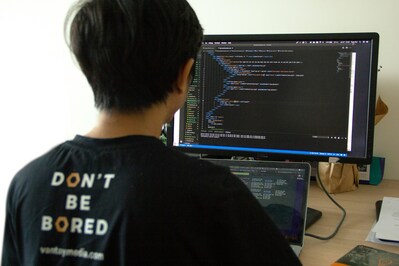
With 16 million developers worldwide and ranking as the third most popular programming language, Python’s influence in web development is undeniable. Specifically, 51% of developers express strong interest in using Python for their projects.
However, your success with Python largely depends on choosing the right python frameworks for your specific needs. Building a data-driven dashboard, handling high-concurrency applications, or creating robust web applications, each framework offers unique advantages. Django provides amazing features with its robust ORM system, and meanwhile Flask’s simplicity makes it perfect for smaller projects and APIs.
While you will read along into this blog you will discover the most important Python frameworks across different categories such as web development or data processing. You will understand which framework best suits your project requirements making sure that you make informed decisions for your development journey.
Choosing the Right Web Framework Based on Project Scope
The Python ecosystem offers remarkable diversity in web frameworks. Your selection should give support with both your immediate development needs and also long-term project goals to ensure the most productive development experience. Selecting the appropriate framework depends primarily on your project’s specific requirements:
- Project size and complexity: For larger projects with extensive backend and frontend needs, full-stack frameworks like Django offer complete solutions. For smaller projects where code flexibility is important, microframeworks like Flask may be preferable.
- Scalability needs: Consider whether your framework can scale vertically or horizontally, especially for applications that will run on multiple servers or handle heavy traffic loads.
- Learning resources: Frameworks with shorter learning curves and complete documentation eases the development of documentation. Some frameworks are more flexible, while others throw errors even for minor mistakes.
- Core library features: Evaluate the framework’s core library as it ensures reduced repetitive code while also providing the level of control of your application.
- Installation and deployment: Some frameworks require elaborate installation steps that may impact deployment even if they are efficient. Some frameworks with simpler installation interfaces often provide easier deployment paths.
LambdaTest offers a scalable cloud-based testing platform that pairs with Python-based automation frameworks.
With out-of-the-box support, LambdaTest enables developers and QA teams to execute automated Selenium tests across 5000+ real browsers and operating systems. Its features, like parallel test execution, geolocation testing, smart visual UI testing, and real-time debugging make it incredibly efficient for Python users looking to achieve faster feedback and greater test coverage.
Whether you’re running simple unit tests or complex end-to-end flows, LambdaTest makes Python automation more powerful and production-ready.
Role of Selenium Python Testing
Widely used open source tool for web automation testing is Selenium. It supports multiple programming languages as Python, Java, C#, Perl, Ruby and JavaScript. It enables the developers to create automated test scripts as its a versatile framework. Developers are enabled to create automated test scripts which interact with web applications across browsers and platforms.
- Simplicity and readability: Python’s servers a clear, concise syntax and allows faster script development and is easier to maintain
- Rich library ecosystem: Python’s extensive libraries complement Selenium functionality
- Community support: Abundant resources for troubleshooting and improvement
Setting up Selenium with Python involves installing the Selenium WebDriver and composing a compatible browser. Notably, since Selenium version 4.6, you no longer need to download browser drivers separately, as the Selenium Manager handles this automatically. Many testing teams opt for cloud-based solutions like LambdaTest, which enables testing across multiple browsers and platforms simultaneously without relying on local hardware.
Web Development Frameworks
Python web frameworks serve as an important tool kit which eliminates the need to handle low level details like protocols, sockets, or thread management while you are building web applications. These frameworks fall into varied categories based on their architecture and feature set, ranging from comprehensive solutions to minimalist approaches.
Django
Django stands as Python’s premier full-stack framework, created for developers who value efficiency and clean design. Known as “the web framework for perfectionists with deadlines,” Django enables you to build high-performing web applications quickly with less code. What makes Django particularly valuable is its comprehensive approach:
- Built-in admin interface: A ready-to-use administration panel
- ORM system: Custom object-relational mapping for database interactions
- Security focus: Takes security seriously to help developers avoid common mistakes
- MTV architecture: Model-Template-View pattern for organized code structure
Django provides everything that the developers need out of the box as it follows the ‘batteries-included’ philosophy. By doing so this approach makes it extremely scalable and allows it to power some of the busiest websites on the web. And being amongst the first frameworks to support Python 3 shows its commitment to keep up with Python’s evolution.
Flask and Bottle
For projects requiring more flexibility and customization, microframeworks offer alternatives which are Flask and Bottle, representing two popular options in this category. It utilizes the Werkzeug WSGI toolkit and Jinja2 templates to provide a solid foundation that can be tailored to your specific needs. Unlike others, Flask doesn’t force any project architecture but offers recommendations through packages, modules, and blueprints.
Bottle takes minimalism even further. As one of the smallest Python web frameworks, it attempts to execute everything in a single source file with no dependencies outside the Python Standard Library. It was initially designed for constructing web APIs, Bottle provides essential features like routing, templates, and access to form data without the overhead of larger frameworks.
Key differences between Flask and Bottle:
- Template engines: Flask uses Jinja2 (more advanced features), while Bottle has its own built-in simple templating engine
- Extension ecosystem: Flask boasts a larger and more mature extension ecosystem compared to Bottle
- Server capabilities: Bottle includes a built-in HTTP server, whereas Flask requires external servers like Gunicorn for production
- Community support: Flask has a larger and more active community with extensive documentation
Pyramid
Pyramid occupies a unique position between full-stack frameworks and microframeworks. As part of the Pythons project, it integrates various web-related technologies while maintaining extraordinary flexibility.
Pyramid’s standout characteristic is its ability to “start small and finish big”. You can begin with a minimal application and gradually add components as your project grows. This scalability is supported by Pyramid’s exceptional extension system and architecture that maintains performance throughout development.
Unlike Django, Pyramid doesn’t dictate a specific ORM or template engine. It allows you to select the tools that best fit your requirements. This flexibility extends to routing, where Pyramid offers a unique system that allows multiple views to match a single URL.
Web2py and TurboGears
Beyond Django, other full-stack frameworks deserve consideration for complex applications.
Web2py focuses on security, development speed, and ease of use. It provides numerous features out of the box, including a web server, database, admin panel, and wiki capabilities. Highly inspired by Ruby on Rails and Django, Web2py enforces an MVC structure with its own Database Abstraction Layer. An interesting feature is its “admin” app, which functions as a web-based IDE for application development and management.
TurboGears takes a different approach by connecting various external services into one cohesive framework. Built on the experience from several next-generation frameworks including TurboGears 1, Django, and Rails, it can start as a single-file application through its minimal mode setup and scale to a full-stack solution for complex applications.
TurboGears combines multiple components:
- SQLAlchemy for database operations
- Kajiki templating engine
- Support for multiple data exchange formats
- Built-in extensibility through pluggable applications
Tornado
Tornado performs differently from other async frameworks and has emerged as one of Python’s earliest asynchronous frameworks. Unlike many Python web frameworks, Tornado isn’t based on WSGI and typically runs with just one thread per process. This framework excels at three core capabilities:
- Handling long-lived connections: Tornado can scale to tens of thousands of open connections through non-blocking network I/O
- WebSocket support: Native WebSocket capabilities make real-time applications straightforward to implement
- Integration with asyncio: Since version 5.0, Tornado shares the same event loop as Python’s standard asyncio module
Despite not being the fastest option, its reliability for long-polling and WebSocket applications makes it valuable for specific use cases. Tornado is designed for Unix-like platforms, with best performance and scalability on supporting systems. Conversely, Windows support exists but isn’t officially recommended for production use, with certain features missing and scalability limitations.
FastAPI: Modern API Development with Async Support
FastAPI stands out as a modern, high-performance framework that combines the simplicity of Flask with native async support. This framework takes full advantage of Python’s async features while maintaining clear syntax. What distinguishes FastAPI is its pragmatic approach to asynchronous programming:
- You can mix synchronous and asynchronous code as needed
- The framework optimizes performance automatically based on your function definitions
- Built-in support for both async def and regular def path operations
One key advantage lies in FastAPI’s ability to capitalize on Python’s modern typing system, generating automatic documentation and validation from your code. This balance between performance and developer experience makes it increasingly popular for new projects. Testing remains essential in modern development workflows as applications grow more complex. Python offers several robust testing frameworks that streamline this crucial process. These frameworks provide structured environments for validating code functionality, automating repetitive tests, and ensuring consistent results across platforms.
Robot Framework: Keyword-Driven Testing
Robot Framework represents a Python-based, extensible automation framework primarily focused on acceptance testing. This open-source solution operates through keyword-driven testing—a methodology using action words to determine functionality under test.
The framework offers several notable features:
- Easy-to-use tabular syntax: Creates uniform test cases with clear readability
- Reusable higher-level keywords: Build from existing keywords to create more complex operations
- HTML reports and logs: Generates comprehensive test results
- Platform independence: Works across operating systems and applications
- Simple library API: Create custom test libraries with Python
- Command line interface: Integrates easily with continuous integration systems
Robot Framework’s architecture separates the test data from its implementation. This division makes it particularly useful for acceptance testing and collaboration between technical and non-technical team members. Its modular structure processes test data, executes test cases, and generates detailed logs without requiring knowledge of the system under test.
Behave and Lettuce: Behavior-Driven Development
For teams adopting behavior-driven development (BDD), Python offers specialized frameworks that bridge technical implementation with business requirements. Behave and Lettuce represent two popular options in this category.
Behave stands as one of the most widely used Python BDD frameworks. While not officially part of the Cucumber project, it functions similarly by supporting the Gherkin language. This approach allows teams to write tests in a human-readable format with Given/When/Then syntax.
The choice between these frameworks often depends on team composition, project complexity, and specific testing requirements. For projects requiring extensive collaboration with non-technical stakeholders, these BDD frameworks offer considerable advantages over traditional testing approaches.
Conclusion
Python frameworks offer remarkable versatility across web development, asynchronous processing, automation or regression testing, and data analysis. Each framework addresses specific needs – Django excels at comprehensive web applications, FastAPI handles high-performance APIs and Flask and bottle minimizes testing approach.
Selecting appropriate frameworks requires careful consideration of your project scope, performance requirements, and team expertise. The Python ecosystem continues evolving, with frameworks adapting to modern development demands and enabling cross-platform applications, and data processing tools handle everything from basic analysis to distributed computing.
Therefore, success with Python development depends on matching frameworks to specific project needs rather than following trending choices. Understanding each framework’s strengths allows you to build efficient, maintainable applications while avoiding unnecessary complexity.


